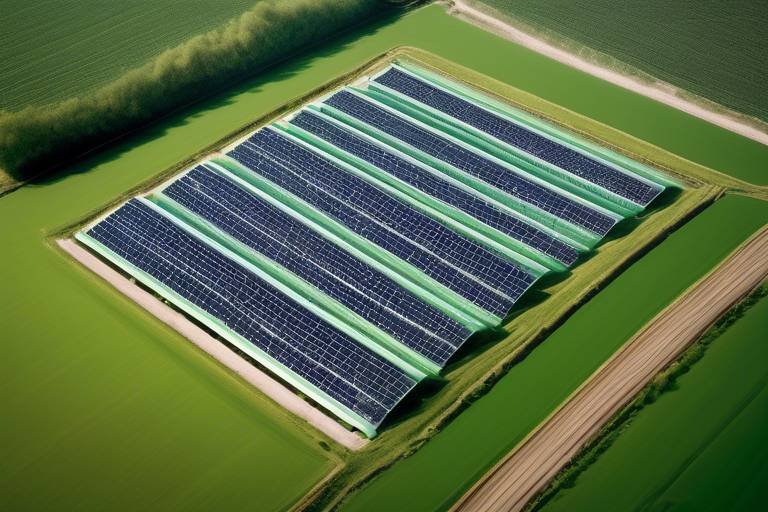Exploring the Concept of Green Energy Certificates
In today's world, where environmental concerns are at the forefront of global discussions, the concept of green energy certificates has emerged as a beacon of hope. These certificates serve as tangible proof that energy has been generated from renewable sources, such as wind, solar, and hydroelectric power. Imagine a world where every time you flip a switch, you're not just consuming energy, but actively contributing to a cleaner planet. That's the promise of green energy certificates, which allow consumers and businesses alike to support sustainable energy practices while reducing their carbon footprints.
So, what exactly do these certificates entail? At their core, green energy certificates represent the environmental benefits associated with renewable energy generation. When a renewable energy producer generates electricity, they receive a certificate for every megawatt-hour of energy produced. This not only incentivizes the production of clean energy but also creates a market where these certificates can be bought and sold, fostering a vibrant ecosystem of green energy investment.
The significance of green energy certificates extends beyond mere transactions; they play a crucial role in tracking and verifying renewable energy generation. This tracking mechanism ensures that stakeholders can confidently claim their energy usage is sustainable. It’s akin to having a badge of honor that showcases your commitment to the environment. The transparency and accountability provided by these certificates enhance consumer trust, allowing individuals to make informed choices about their energy consumption.
Moreover, green energy certificates are instrumental in promoting environmental sustainability. By encouraging businesses and consumers to invest in cleaner energy options, they help reduce greenhouse gas emissions and combat climate change. It's like planting seeds for a greener future; with every certificate traded, you're nurturing the growth of renewable energy sources that will benefit generations to come.
In essence, green energy certificates are not just paper; they represent a movement towards a more sustainable and eco-friendly world. They embody the collective effort to transition away from fossil fuels and embrace renewable energy solutions. As we explore the intricate mechanisms and benefits of these certificates, it becomes clear that they are a vital tool in the fight against climate change and a key player in the shift towards a sustainable energy future.
- What is a green energy certificate? A green energy certificate is proof that energy has been produced from renewable sources, allowing consumers to support sustainable energy practices.
- How do green energy certificates work? They function as tradable commodities that represent the environmental benefits of renewable energy generation, creating a market for green energy investment.
- Why are green energy certificates important? They incentivize renewable energy production, help reduce greenhouse gas emissions, and encourage businesses and consumers to invest in cleaner energy options.
- What challenges do green energy certificates face? Challenges include market volatility, regulatory inconsistencies, and the risk of greenwashing, which can undermine their effectiveness.

What Are Green Energy Certificates?
Green energy certificates are more than just pieces of paper; they are a vital part of the renewable energy landscape. Think of them as badges of honor for energy producers who harness the power of nature—like wind, solar, or hydro—to generate electricity. Each certificate signifies that a specific amount of energy (typically one megawatt-hour) has been produced from renewable sources, effectively acting as proof that this energy is clean and sustainable.
When you purchase a green energy certificate, you're not just buying a document; you're investing in a greener future. These certificates facilitate the tracking of renewable energy generation, allowing consumers and businesses to support sustainable practices without needing to install solar panels on their rooftops or wind turbines in their backyards. It's a win-win situation that encourages the growth of renewable energy while giving consumers a direct way to contribute to environmental sustainability.
To better understand the significance of green energy certificates, consider the following points:
- Verification: They provide a reliable method for verifying that energy comes from renewable sources, ensuring transparency in the energy market.
- Market Mechanism: Green energy certificates create a market where these certificates can be traded, allowing for financial incentives for renewable energy producers.
- Consumer Choice: They empower consumers to choose green energy, encouraging more people to invest in sustainable energy options.
Ultimately, green energy certificates serve as a bridge between renewable energy producers and environmentally conscious consumers. They help create a more sustainable world by promoting the use of clean energy and reducing our reliance on fossil fuels. As more people become aware of the benefits of green energy, the demand for these certificates is likely to grow, further driving the shift toward a sustainable energy future.

The Importance of Green Energy Certificates
Green energy certificates are not just a trendy buzzword; they are a critical component of our transition towards a sustainable future. Imagine a world where every kilowatt of energy consumed is sourced from renewable resources like wind, solar, or hydroelectric power. Green energy certificates (GECs) make this vision a reality by providing a mechanism to track and verify the production of renewable energy. In essence, they serve as a badge of honor for energy producers, signaling their commitment to environmental stewardship.
One of the most significant roles of green energy certificates is to incentivize renewable energy production. By creating a market for these certificates, energy producers can sell them alongside the actual energy they generate. This additional revenue stream encourages investments in renewable technologies, allowing for greater innovation and expansion of clean energy sources. Without GECs, many renewable energy projects might struggle to find the funding necessary to get off the ground.
Moreover, GECs contribute significantly to the reduction of greenhouse gas emissions. When businesses and consumers purchase these certificates, they are effectively offsetting their carbon footprints. This action not only helps in meeting regulatory requirements but also fosters a culture of sustainability. Companies that actively engage in purchasing green energy certificates often see a boost in their brand reputation, as consumers are increasingly drawn to businesses that prioritize environmental responsibility.
In addition to promoting cleaner energy sources, green energy certificates also play a vital role in enhancing consumer awareness. As people become more conscious of their energy consumption, they are more likely to seek out sustainable options. GECs provide a straightforward way for consumers to support renewable energy initiatives. By investing in these certificates, they are not only contributing to a healthier planet but also influencing market trends. This consumer-driven demand for green energy can lead to a ripple effect, pushing more companies to adopt sustainable practices.
Furthermore, green energy certificates facilitate transparency in the energy market. When stakeholders can easily track the source of their energy, it builds trust among consumers. This transparency is essential in today's world, where misinformation can easily spread. By providing a clear link between energy production and consumption, GECs help to ensure that the energy market operates with integrity.
In summary, the importance of green energy certificates cannot be overstated. They are a powerful tool for promoting renewable energy production, reducing greenhouse gas emissions, enhancing brand reputation, and increasing consumer awareness. As we continue to navigate the challenges of climate change, GECs will undoubtedly play a pivotal role in shaping a more sustainable energy landscape.
- What is a green energy certificate? A green energy certificate is proof that energy has been produced from renewable sources, helping to track and verify renewable energy generation.
- How do green energy certificates reduce carbon footprints? By purchasing GECs, businesses and consumers can offset their carbon emissions, supporting renewable energy initiatives.
- Can individuals purchase green energy certificates? Yes, individuals can buy GECs through various platforms, allowing them to contribute to renewable energy production.
- What challenges do green energy certificates face? Challenges include market volatility, regulatory inconsistencies, and the risk of greenwashing, which can undermine their credibility.

How Green Energy Certificates Work
Green Energy Certificates (GECs) are fascinating instruments that bridge the gap between renewable energy production and consumer awareness. Essentially, these certificates serve as proof that a certain amount of energy has been generated from renewable sources, such as wind, solar, or hydroelectric power. When a renewable energy producer generates electricity, they receive a GEC for each megawatt-hour (MWh) produced. This means that every time you flip a switch and power up your device, you could be supporting a cleaner planet, thanks to these certificates!
But how does this all work in practice? Imagine a farmer growing organic vegetables. They don’t just sell the veggies; they also offer a certification proving that their produce is organic. Similarly, GECs provide a way for energy producers to demonstrate that their energy is green. Once these certificates are issued, they can be traded in a marketplace, allowing businesses and consumers to purchase them to offset their carbon footprints. This trading creates a financial incentive for renewable energy production, making it more attractive for companies to invest in sustainable practices.
To further illustrate the process, let’s break it down into simple steps:
- Energy Generation: A renewable energy facility generates electricity.
- Certification Issuance: For every MWh produced, a GEC is issued, confirming the energy's renewable origin.
- Trading: These certificates can be bought and sold in a marketplace, allowing companies to purchase them to claim they are using renewable energy.
- Consumer Impact: By buying GECs, consumers and businesses can support renewable energy initiatives and reduce their carbon footprint.
This system not only promotes transparency but also enhances the credibility of renewable energy sources. Stakeholders can track the certificates through various registries, ensuring that the energy being claimed as renewable is indeed sourced from sustainable methods. This transparency builds trust among consumers who are increasingly looking for ways to make environmentally friendly choices.
Moreover, the market dynamics of GECs are influenced by several factors, such as regulatory frameworks and consumer preferences. For instance, if more consumers demand renewable energy, the price of GECs may increase, making it more profitable for energy producers to invest in green technologies. Conversely, if there’s a surplus of certificates, prices may drop, impacting the financial viability of renewable energy projects. Understanding these dynamics is crucial for anyone looking to navigate the green energy landscape effectively.
In summary, Green Energy Certificates serve as a vital mechanism in promoting renewable energy production. They empower consumers, incentivize businesses, and contribute to a more sustainable future. By participating in this market, everyone can play a role in supporting renewable energy and reducing their environmental impact.

Tracking Renewable Energy Production
When we talk about , we're diving into a system that ensures transparency and accountability in the renewable energy sector. Imagine a world where every kilowatt of green energy produced is not just a number but a verified achievement. This is where green energy certificates come into play. They act as a badge of honor for renewable energy producers, proving that the energy they generate is sourced from sustainable methods. By tracking these certificates, stakeholders can easily verify the origin of their energy, giving consumers the confidence they need to support green initiatives.
So, how does this tracking work in practice? It involves several key components:
- Verification Processes: Third-party organizations assess and verify the energy produced from renewable sources. This ensures that the certificates issued are legitimate and represent actual green energy generation.
- Registry Systems: These systems maintain a comprehensive database of all green energy certificates issued. They track the lifecycle of each certificate, from its creation to its sale and retirement, ensuring that no double counting occurs.
- Consumer Awareness: By providing information about where their energy comes from, consumers can make informed choices. This awareness not only fosters trust but also drives demand for renewable energy.
Furthermore, the tracking of renewable energy production is vital for businesses aiming to enhance their sustainability profiles. Companies can proudly showcase their commitment to green energy by presenting their certificates, which can improve their brand reputation and attract environmentally conscious consumers. In a world where sustainability is becoming increasingly important, these certificates serve as a powerful tool for marketing and public relations.
However, it’s essential to recognize that tracking is not just beneficial for producers and consumers; it also plays a crucial role in achieving national and global sustainability goals. Governments and organizations can monitor progress towards renewable energy targets, ensuring that commitments to reduce carbon emissions are being met. This tracking mechanism creates a feedback loop that encourages continual improvement in energy production practices.
In conclusion, the tracking of renewable energy production through green energy certificates is a game-changer. It not only enhances transparency and trust but also empowers consumers and businesses to make sustainable choices. As we move towards a greener future, understanding and supporting these tracking systems will be vital in promoting renewable energy and reducing our carbon footprints.
- What are green energy certificates? Green energy certificates are proof that energy has been produced from renewable sources, allowing consumers to support sustainable energy practices.
- How do green energy certificates work? They function as tradable commodities that represent the environmental benefits of renewable energy generation.
- Why are tracking systems important? They ensure transparency, prevent double counting, and help consumers make informed choices about their energy sources.
- Can businesses benefit from green energy certificates? Yes, businesses can enhance their brand reputation and attract eco-conscious consumers by showcasing their commitment to renewable energy.

Market Dynamics of Green Energy Certificates
The market dynamics surrounding green energy certificates are as vibrant and complex as the renewable energy landscape itself. These dynamics are influenced by a variety of factors, including supply and demand, regulatory frameworks, and evolving consumer preferences. Understanding these elements is crucial for anyone looking to navigate the green energy market effectively. Just like any commodity, the value of green energy certificates fluctuates based on how many are available versus how many people want to buy them. For example, if more renewable energy is being produced than there are buyers for the certificates, prices may drop. Conversely, if demand outstrips supply, we could see a surge in prices, making it a lucrative market for producers.
Moreover, government policies play a pivotal role in shaping this market. They can create incentives for renewable energy production, thereby increasing the supply of green energy certificates. For instance, many countries have set ambitious targets for renewable energy adoption, which can lead to a greater issuance of these certificates. On the flip side, if regulations tighten or become inconsistent, it may discourage investment in renewable energy, leading to a decrease in supply and a potential rise in prices.
Another significant factor is consumer awareness and demand for sustainable practices. As individuals and businesses become more environmentally conscious, their willingness to invest in green energy certificates increases. This shift in consumer behavior is akin to a ripple effect; as more people opt for sustainable energy solutions, the market for green energy certificates expands. Companies that actively promote their use of these certificates often find themselves in a better position to attract eco-conscious customers, which can enhance their brand reputation and market share.
To illustrate the market dynamics further, consider the following table that summarizes key factors affecting the market for green energy certificates:
| Factor | Influence on Market |
|---|---|
| Supply and Demand | Prices fluctuate based on availability and buyer interest. |
| Government Policies | Incentives can boost supply; inconsistent regulations can hinder growth. |
| Consumer Preferences | Increasing demand for sustainability drives market expansion. |
In conclusion, the market dynamics of green energy certificates are shaped by a delicate balance of supply, demand, regulatory influences, and consumer behavior. As the world moves towards a more sustainable future, understanding these dynamics will be essential for stakeholders looking to make informed decisions in the green energy sector.
- What are green energy certificates? Green energy certificates are proof that energy has been produced from renewable sources, allowing consumers to support sustainable practices.
- How do green energy certificates benefit the environment? They incentivize renewable energy production, helping to reduce greenhouse gas emissions and promote sustainability.
- What challenges do green energy certificates face? Challenges include market volatility, regulatory inconsistencies, and the potential for greenwashing.

Benefits of Green Energy Certificates
Green Energy Certificates (GECs) are more than just pieces of paper; they are powerful tools that can transform the energy landscape. By purchasing these certificates, consumers and businesses alike can actively participate in the renewable energy revolution. But what exactly are the benefits of engaging with GECs? Let’s dive into some of the most significant advantages that come with supporting green energy initiatives.
First and foremost, GECs provide financial incentives for renewable energy producers. When energy companies generate electricity from renewable sources such as wind, solar, or hydro, they receive these certificates as proof of their green energy production. This not only helps them earn additional revenue but also encourages further investment in renewable technologies. Imagine a world where every kilowatt of clean energy produced is rewarded; that’s the potential of GECs!
Moreover, businesses that engage in purchasing GECs can enhance their brand reputation. In today’s eco-conscious market, consumers are increasingly looking for companies that prioritize sustainability. By showcasing their commitment to green energy through GECs, businesses can attract environmentally aware customers and differentiate themselves from competitors. Think of it as a badge of honor—one that signifies a company’s dedication to a cleaner, greener planet.
Additionally, GECs play a crucial role in raising consumer awareness about the importance of sustainable energy sources. As more individuals learn about the existence and benefits of GECs, they are likely to make more informed decisions regarding their energy consumption. This ripple effect can lead to a greater demand for renewable energy, ultimately pushing more companies to adopt sustainable practices. It’s like planting seeds of knowledge that can grow into a forest of positive environmental change!
Furthermore, the tradeability of GECs creates a dynamic marketplace that can stimulate economic growth. By providing a platform for buying and selling these certificates, a new economic ecosystem is formed, allowing for innovation and job creation in the renewable energy sector. This market not only benefits producers but also opens up opportunities for investors looking to support sustainable initiatives. Just like a bustling marketplace filled with fresh produce, the GEC market thrives on the exchange of ideas and resources.
Lastly, GECs contribute to the overall reduction of carbon footprints. By incentivizing the production and consumption of renewable energy, these certificates help lower greenhouse gas emissions. When consumers choose to support renewable energy through GECs, they are actively participating in the fight against climate change. It’s a collective effort where every small action counts, and together, we can make a significant impact.
In summary, the benefits of Green Energy Certificates extend far beyond financial gains. They foster a culture of sustainability, enhance brand loyalty, raise awareness, stimulate economic growth, and contribute to a healthier planet. As we navigate the complexities of energy consumption, embracing GECs can be a game-changer for individuals and businesses alike.
- What are Green Energy Certificates?
Green Energy Certificates are tradable commodities that represent proof that energy has been produced from renewable sources. - How do Green Energy Certificates benefit consumers?
Consumers can support renewable energy initiatives and enhance their brand loyalty by purchasing GECs. - Can businesses profit from Green Energy Certificates?
Yes, businesses can earn additional revenue by producing renewable energy and selling the corresponding GECs. - What impact do GECs have on the environment?
GECs help reduce greenhouse gas emissions and promote sustainable energy practices.

Challenges Facing Green Energy Certificates
While green energy certificates (GECs) present a promising avenue for promoting renewable energy, they are not without their challenges. One of the primary hurdles is the regulatory inconsistency that plagues the market. Different regions may have varying policies and regulations regarding the issuance and trading of these certificates, leading to confusion among stakeholders. For instance, a renewable energy producer in one state may benefit from generous incentives, while another in a neighboring state faces stringent restrictions. This patchwork of regulations can stifle the growth of renewable energy markets and make it difficult for businesses to navigate the landscape.
Furthermore, market volatility is another significant challenge that can undermine the effectiveness of green energy certificates. The prices of GECs can fluctuate wildly based on supply and demand dynamics, which can be influenced by factors such as consumer preferences, technological advancements, and even geopolitical events. This volatility can deter investment in renewable energy projects, as producers may be uncertain about the financial viability of their ventures. Additionally, if the market becomes too unstable, it could lead to a lack of confidence among consumers and businesses alike.
Another pressing issue is the risk of greenwashing. As more companies strive to enhance their sustainability credentials, some may falsely claim to be using renewable energy without any real commitment to environmental practices. This deceptive practice can undermine the credibility of green energy certificates and erode consumer trust. To combat this, it is essential for regulatory bodies to implement stringent verification processes that ensure the integrity of the certificates being issued. Without proper oversight, the market could become saturated with misleading claims, making it difficult for consumers to distinguish between genuine renewable energy sources and those merely seeking to capitalize on the green trend.
In summary, while green energy certificates offer significant potential for promoting sustainable energy, they face considerable challenges that must be addressed. The interplay of regulatory inconsistencies, market volatility, and the threat of greenwashing requires careful navigation by all stakeholders involved. By fostering a transparent and accountable system, we can ensure that green energy certificates fulfill their purpose of driving the transition toward a more sustainable future.
- What are green energy certificates? Green energy certificates are tradable commodities that represent proof that energy has been produced from renewable sources.
- How do green energy certificates work? They function by allowing producers to sell the environmental benefits of their renewable energy generation, creating a market for green energy investment.
- What challenges do green energy certificates face? Key challenges include regulatory inconsistencies, market volatility, and the risk of greenwashing.
- Why are green energy certificates important? They incentivize renewable energy production, help reduce greenhouse gas emissions, and promote environmental sustainability.

Regulatory Challenges
The journey towards a sustainable energy future is often paved with regulatory challenges that can impede the effectiveness of green energy certificates. One of the primary hurdles is the inconsistency of policies across different regions. For instance, while some countries have robust frameworks promoting renewable energy, others may lag behind, creating a patchwork of regulations that can confuse stakeholders. This inconsistency can lead to a lack of clarity regarding the rules governing the issuance and trading of green energy certificates, making it difficult for both producers and consumers to navigate the landscape.
Furthermore, the regulatory environment can change rapidly, influenced by political shifts, economic considerations, or public sentiment. Such volatility can create uncertainty for businesses that invest heavily in renewable energy initiatives, as they may find themselves subject to new rules or changes in existing policies that affect their operations. For example, sudden cuts to subsidies or tax incentives can deter investment in green technologies, undermining the very goals that green energy certificates aim to achieve.
Another significant challenge is the need for a standardized approach to measuring and verifying renewable energy generation. Without universally accepted metrics, it becomes challenging to ensure that the certificates accurately represent the environmental benefits of the energy produced. This lack of standardization can lead to discrepancies in reporting and tracking, resulting in skepticism among consumers and investors about the integrity of the green energy market.
Moreover, the potential for regulatory capture—where regulatory agencies become influenced by the industries they are supposed to regulate—can further complicate the situation. If the interests of fossil fuel companies or other non-renewable energy sources begin to overshadow those of renewable energy producers, it could stifle innovation and slow down the transition to cleaner energy sources. This underscores the importance of maintaining a balanced regulatory framework that prioritizes sustainability and environmental protection.
To address these regulatory challenges, it is essential for stakeholders, including policymakers, businesses, and consumers, to engage in open dialogues. Collaborative efforts can lead to the development of more coherent policies that not only promote renewable energy but also build trust in the green energy certificates system. By fostering a transparent regulatory environment, we can pave the way for a more sustainable future and ensure that green energy certificates fulfill their intended purpose.
- What are green energy certificates? Green energy certificates are tradable commodities that represent proof that energy has been produced from renewable sources.
- Why are green energy certificates important? They incentivize renewable energy production, help reduce greenhouse gas emissions, and promote environmental sustainability.
- How do green energy certificates work? They provide a market for renewable energy investment by allowing certificates to be bought and sold, representing the environmental benefits of renewable energy generation.
- What challenges do green energy certificates face? Challenges include market volatility, regulatory inconsistencies, and the potential for greenwashing.
- How can regulatory challenges be addressed? By fostering open dialogues among stakeholders and developing coherent policies that prioritize sustainability.

Market Volatility and Greenwashing
Market volatility is a significant concern in the realm of green energy certificates. Just like the stock market, the prices of these certificates can fluctuate based on a variety of factors, including supply and demand, regulatory changes, and consumer sentiment. For instance, when more renewable energy is produced than the market can absorb, prices may drop, discouraging further investment in clean energy initiatives. This creates a cycle where instability can lead to hesitancy among producers and investors alike, ultimately stifling the growth of the renewable energy sector.
Moreover, the phenomenon of greenwashing complicates the landscape even further. Greenwashing occurs when companies exaggerate or misrepresent their environmental efforts to appear more sustainable than they actually are. This not only misleads consumers but also undermines genuine efforts made by companies committed to real sustainability practices. Imagine walking into a store that claims to sell organic products, only to find out that many items are just labeled as such without any real adherence to organic standards. This deception can erode consumer trust, making it difficult for those truly committed to green practices to stand out in a crowded market.
To illustrate the impact of market volatility and greenwashing, consider the following table that outlines some of the key challenges and their effects:
| Challenge | Effect |
|---|---|
| Market Volatility | Discourages investment in renewable energy projects |
| Greenwashing | Erodes consumer trust and complicates market credibility |
| Regulatory Inconsistencies | Creates confusion and limits market growth |
Addressing these challenges is essential for the success of green energy certificates. Stakeholders must work together to establish clearer regulations that promote transparency and integrity in the market. This could involve setting standards for what constitutes a legitimate green energy project, thus helping to differentiate between genuine efforts and those that are merely superficial. By fostering an environment where true sustainability is recognized and rewarded, we can ensure that green energy certificates fulfill their purpose of promoting renewable energy and reducing carbon footprints effectively.
- What are green energy certificates? Green energy certificates are tradable commodities that represent proof that energy has been produced from renewable sources.
- How do green energy certificates work? They provide a way for renewable energy producers to sell the environmental benefits of their energy generation, creating a financial incentive for clean energy production.
- What challenges do green energy certificates face? Challenges include market volatility, regulatory inconsistencies, and the risk of greenwashing, which can undermine the credibility of the system.
- How can consumers identify genuine green energy initiatives? Consumers should look for certifications from recognized organizations and seek transparency in the claims made by companies regarding their environmental practices.
Frequently Asked Questions
- What exactly are green energy certificates?
Green energy certificates, often referred to as renewable energy certificates (RECs), are tangible proof that a specific amount of energy has been generated from renewable sources such as wind, solar, or hydro. They serve as a tracking mechanism for renewable energy production, allowing consumers and businesses to support green energy initiatives.
- Why are green energy certificates important?
These certificates play a crucial role in promoting renewable energy by providing financial incentives for producers. They help reduce greenhouse gas emissions and encourage investment in sustainable energy options, ultimately benefiting the environment and society at large.
- How do green energy certificates work?
Green energy certificates function as a tradable commodity that represents the environmental benefits of renewable energy generation. When energy is produced from renewable sources, a corresponding certificate is issued. These certificates can then be bought and sold, creating a market that incentivizes green energy investments.
- How is renewable energy production tracked?
Renewable energy production is tracked through a system of certificates that ensures transparency and accountability. This tracking allows stakeholders, including consumers, to verify the source of their energy, fostering trust in green energy initiatives.
- What are the benefits of green energy certificates?
Green energy certificates offer several advantages, including financial benefits for renewable energy producers, improved brand reputation for companies that invest in sustainable practices, and heightened consumer awareness about the importance of renewable energy sources.
- What challenges do green energy certificates face?
Despite their benefits, green energy certificates encounter challenges like market volatility, regulatory inconsistencies, and the risk of greenwashing. Addressing these issues is essential for ensuring the effective implementation and credibility of the system.
- What are regulatory challenges in the context of green energy certificates?
Regulatory challenges can significantly impact the effectiveness of green energy certificates. Inconsistent policies across different regions can create confusion and hinder the growth of renewable energy markets, making it difficult for stakeholders to navigate the landscape.
- How do market volatility and greenwashing affect green energy certificates?
Market volatility can undermine the stability and reliability of green energy certificates, while greenwashing—where companies falsely claim to be environmentally friendly—can damage consumer trust. Ensuring market integrity and transparency is vital for maintaining confidence in genuine sustainability efforts.



















